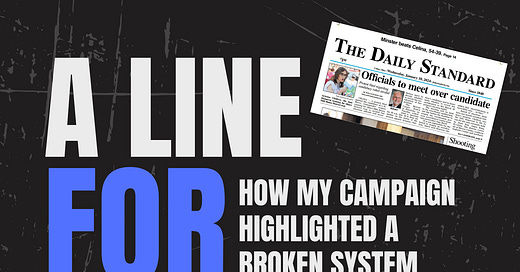Back in late December or early January of 2024, I learned about the disqualification of Vanessa Joy, a fellow trans woman who attempted to run for the Ohio Statehouse. She was removed from the ballot due to an obscure name change provision buried in state law. That evening, I pored over candidate forms, the guide, and the Ohio Revised Code to understand the issue. My heart sank as I realized I, too, could be targeted under the same provision.
The days that followed were a flurry of activity. I reached out to attorneys and party leadership to figure out my next steps. Then, on my birthday—January 5th—while I was at dinner with my husband, news broke that the Mercer County Republican Party Chair had filed a protest against my candidacy. My phone buzzed constantly over the next week with calls from reporters seeking interviews.
In those interviews, I, along with other impacted candidates, pointed out the glaring flaws in the system. The name change provision wasn’t mentioned anywhere in the candidate guide or on the forms, and there was no space on the forms to even attempt compliance. Republican officials and online trolls dismissed our concerns, insisting the rule was fair and justified.
I made it clear: while I strongly disagree with forcing trans individuals to deadname themselves, I would have complied had I been made aware and provided the means to do so. As it stood, the law demanded something of us without giving any way to meet its requirements. It was effectively a de facto ban on transgender candidates. Yet, our concerns were brushed aside by those eager to enforce the seldom-used provision.
Ultimately, the attempt to remove me from the ballot failed. Ironically, my opponent’s party violated another election provision in their zeal to disqualify me. Their case unraveled because the law clearly stated that opposing parties lacked standing to challenge primary candidates. Yet, instead of admitting defeat, my opponent doubled down, introducing a bill to make cross-party challenges legal. This bill, passed during the 2024 lame-duck session, now allows one party to protest a primary candidate from the other.
Here’s the twist: that law won’t even apply to me in future elections. By the time I’m ready to run again, the five-year window on the name change provision will have elapsed.
But this isn’t just about me. Remember how our criticisms of the forms were dismissed? How one trans candidate was disqualified and others faced public hearings over a rule they had no way to follow? Well, quietly, without any public acknowledgment, the Secretary of State changed the forms for this year. The new forms now include a line with enough space for both current and former names, along with clear instructions: “Include all prior names used in the past five years, excluding marriage name changes.”
This change validates everything we said. Our complaints were valid, and the Secretary of State knew it. Yet, instead of addressing this issue publicly or explaining the update, the office remained silent. This silence does a disservice to voters and potential candidates alike.
At a time when Ohio’s General Assembly has made LGBTQ+ rights, especially trans rights, a target, many trans individuals are watching closely. They saw what we endured—one candidate disqualified, others subjected to public hearings, and a system rigged against us. How many potential candidates gave up before even starting because compliance was impossible? Now, with this change, there’s at least a path to compliance—however flawed it may be—but the Secretary’s silence means many won’t even know.
Let me be clear: under normal circumstances, a form update wouldn’t warrant a press release. But these aren’t normal circumstances. Frank LaRose and the Ohio GOP know the significance of this change. The new forms would have entirely prevented the chaos they subjected us to. They understand the importance of this update but have chosen to remain quiet.
Potential trans candidates need to know about this change. While I believe forced deadnaming is never acceptable, these updated forms at least give trans individuals the ability to weigh their options and decide if the cost of compliance is worth the opportunity to serve and advocate for inclusion. It’s not the solution I would have chosen, but it’s a step toward ensuring trans voices are not silenced in Ohio’s electoral process.









